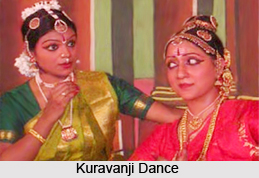Introduction
 Kuravanji dance is performed in the Tamil Nadu state of India. It is said that like the Bhagavatha Mela, Kuravanji dance form of Tamil Nadu is also a cross over dance from Andhra Pradesh. The word "Kura" refers to the tribe `Kuruvas` or `Chenchus`, where the men were the nomadic hunters of Andhra Pradesh, whereas their women folk were reputed fortune-tellers. The word "Anji" is derived from adavus, which means traditional dances. The form is also referred to as kuram and kuluva natakam.
Kuravanji dance is performed in the Tamil Nadu state of India. It is said that like the Bhagavatha Mela, Kuravanji dance form of Tamil Nadu is also a cross over dance from Andhra Pradesh. The word "Kura" refers to the tribe `Kuruvas` or `Chenchus`, where the men were the nomadic hunters of Andhra Pradesh, whereas their women folk were reputed fortune-tellers. The word "Anji" is derived from adavus, which means traditional dances. The form is also referred to as kuram and kuluva natakam.
Performance of Kuravanji Dance
Lord Vighneswara (Ganapati, the elephant-headed god) is the presiding deity for its performance. As the play starts, it depicts the story of Kuravanji. After the salutary procession, the kattiakaran summarizes the story, which in fact is a variation on one theme that runs through all performances. The framework of the dance performance of Kuravanji provides an ideal medium for projection of geography lessons and was utilized skilfully for the same purpose by Maharaja Serfoji II (1798- 1833). In addition to the gypsy women, singers, instrumental musicians and dancing girls are also added to the art.
Types of Kuravanji Dance
There are hundreds of Kuravanjis performed all over the state. Compositions like the `Thirukkutrala Kuravanji are famous for their fluent poetic importance. The Viralimalai Kuravanji is recognized for its musical value. In the Azhagar Kuravanji and the Thirumalai Andavar Kuravanji, a wonderful balance is maintained between music and literature. The Sendil Kuravanji is a dance-drama centering around the theme of the presiding deity of Tiruchendur, where the heroine Madana Mohini appears on the scene. Spending her time in the delightful company of her friends, she sees Lord Arumuga coming in procession and falls in love with him.
History of Kuravanji Dance
The Kuravanji is a South Indian dance form based on free use of techniques of Dasi Attam. The dance form is mainly performed by beautiful young women belonging to the Kuravas Tribes, as they are the main proponent of this dance form. They are well known for their beauty and looks and their cheeks are decorated with dotted designs. The men folk are nomadic people who are basically snake charmers, tumblers and acrobats. Women`s are fortune tellers. They live on precarious situations as they mostly depend on thieving and pilfering. Like many other tribes of India, the Kuravas also are beyond the ambit of the society. They are the unassimilated form of the original Dravidians and who were not given a place in Aryanised society. It may so happen that, some of the members of this tribe were a part of other community who have been expelled from their own caste and found no place in a settled community.
One of the reasons for such a situation was the transgression of Law of Manu concerning sexual misconduct and marriages. Men were given a free hand but if a woman was found to have a relationship with a man of lower caste than her, then she along with her children, were turned out of her home with severe ignominy. She would then have no other alternative but to join a wondering gypsy or become a prostitute. It is these women who made the Kuravanji dance form popular among the Kuravas. There is an unprecedented similarity between this dance form and Dasi Attam, and that is what makes the theory all the more plausible.
The Kuravas were social out caste and had no option other than the Dasi Attam dance form to imitate. This seems to be the only logical explanation for such a close resemblance between the Dasi Attam and Kuravas. The Kuavanji dance form does contain a substantive amount of pre-Aryan dances.
The Kuravas tribes are non caste tribes who were forced into coherent units for the will to survive and out of economic necessity. These tribes were rebuked by the Hindu society and were later exacerbated by the British by classifying them as "criminal tribes". The only friends that these tribes had were the missionaries, who worked towards imparting quality life and education.
Just like the Dasi Attam, the Kuravanji Dance was Shaivite in inspiration. One of the popular and old kuravanji known in India is the Thirukutrala Kuruvanji, which was composed in the honour of Lord Shiva as Thirukudanthar. The other popular ones are Kumbesara and Chitrambala. All these dance forms are performed during the Shaivite festival. And this has been going on for years. However, there is one Kuravanji known as Azhagar that is danced for LordVishnu.
Legends have it that Kuravanji dancers were usually men dressed up as women symbolizing various consorts of Shiva and Vishnu.



















